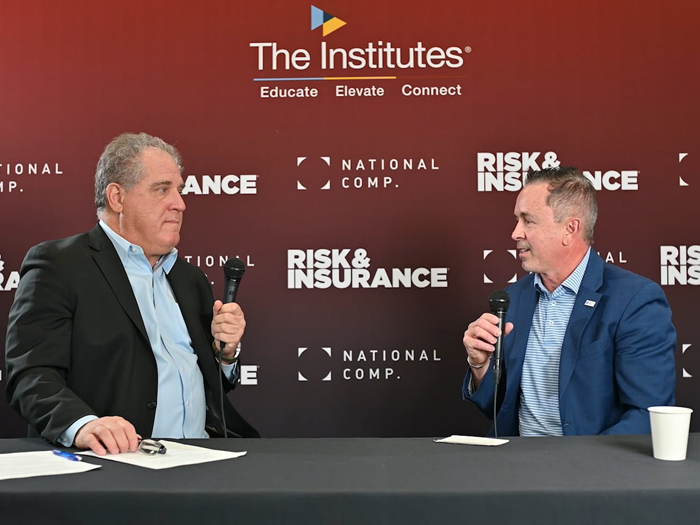BHSI’s Ben Wyatt On Steering Marine Insurance Through Geopolitical Turbulence and Technological Change

As part of our expanded coverage of our 2025 Power Broker® Marine Sector winners and finalists, Risk & Insurance recently spoke to Ben Wyatt, a senior vice president for U.S. Marine with BHSI. What follows is a transcript of that discussion, edited for length and clarity.
Risk & Insurance: Thanks for spending some time with us Ben. Since this conversation aligns with our Power Broker® issue, what qualities and expertise do exceptional marine brokers bring to insurance transactions?
Ben Wyatt: Marine brokers are hugely important in the success of our day to day insurance transactions. Their expertise, work ethic, and knowledge of the customer and Marine industry are crucial to the deals we aim to put together.
Every risk and every customer’s needs in the marine world are unique, ranging from vessels to cargo stock throughput, marine liability, protection and indemnity, and specialist marine risks. Brokers must have a deep understanding of both the market and each individual customer’s requirements and needs.
We always aim to treat each opportunity and submission as a bespoke product due to the significant differences between our customers and their needs. It is essential that the brokers we deal with, and those that customers interact with, have this level of knowledge and understanding.
R&I: What impact have recent international conflicts in the Middle East and Ukraine had on marine insurance capacity and pricing?
BW: The marine insurance market covers a wide range of risks, and a key underwriting principle for us is to understand all exposures that could potentially lead to losses. Ensuring you, your customer and the broker are up to speed on global events such as war and strikes, riots, and civil commotion (SRCC) risks, where such issues are occurring and where potential exposures might be is paramount.
As such and with the heightened global tensions in recent years, particularly in the Middle East and Ukraine, these risks have been brought to the spotlight. Underwriters have to be more careful then ever when considering war and SRCC risks in certain, and ever changing areas, when deploying capacity and managing their exposures.
As a result, the entire marine insurance market has been focusing on managing capacity and deployment for risks that are exposed to these geopolitical events. It has become a top priority for underwriters to navigate these challenges effectively.
R&I: How are supply chain technologies, such as onboard sensors and shipment tracking, helping to avoid cargo losses?
BW: I’ll address this from both risk transfer and risk mitigation perspectives. The data and knowledge gained from these devices are crucial for underwriting decisions, helping underwriters, insurers, and insureds better understand the risks involved.
Given the uniqueness of each risk, the more data we have, the better we can design bespoke risk transfer products through collaboration between brokers, insurers, and insureds. From a risk mitigation standpoint, being proactive is key.
If technology can help us get ahead of a potential claim, situation, or loss, that’s clearly beneficial. However, the effectiveness depends on timing and the mode of transit in the supply chain. For example, it’s easier to stop a truck and pull over if a temperature goes out of specification than it is to do so on a vessel in the middle of the sea.
While there’s still room for improvement in risk mitigation, we’re heading in the right direction. This technology also offers benefits for reactive claims handling situations. Ultimately, it’s all about being as proactive as possible.
R&I: What emerging risks do you see in the marine space?
BW: We see a few emerging risks in the marine space that are important to understand, as they can cause losses in different ways. Supply chain delays are a relevant and well-known issue, and delayed coverage is not always often afforded.
Another emerging risk we see in the supply chain, which is quite concerning, is the increase in the number, frequency, and complexity of cargo thefts. We are witnessing these acts becoming more advanced through falsified documents to accept packages, hacking into load boards to change delivery details and false transactions.
We’re definitely watching the space of technology-based scams and social engineering attacks. These acts are becoming more complicated and advanced, making it very hard for customers to get in front of them.
Another trend we’re acutely aware of is the peril of flood. We’ve been working closely with our catastrophe E&A team, as many new warehouses are being built across the country. These warehouses tend to be constructed on cheaper land, which often comes with a higher flood risk. We’re monitoring this trend and working on modeling flood risk and our geographical footprint with respect to this peril.
Finally, we’re keeping an eye on new emerging products within the global supply chain world, such as battery energy storage systems and lithium-ion batteries. Despite not being entirely new, we still have limited understanding of what causes some lithium-ion battery fires. We’re also aware of the development of electric-powered vessels. Understanding our exposures to these emerging products is crucial for us.
Topically, and depending on the timing of this article’s release, we’ll be closely monitoring the impact of tariffs on the supply chain world over the next few months, although it may be a bit too soon to say right now.
R&I: What impact is climate change having on marine exposures beyond inland flooding?
BW: In addition to inland flooding, we’re carefully monitoring the impact of wildfires on marine exposures. The increasing strength, frequency, and active nature of storm seasons is also a significant concern.
To mitigate these risks, we’re seeing more protections, and we are working towards better data sharing from warehouses. This includes information on storm surge, flooding, and the height at which goods are stored off the ground. Knowledge and data are powerful assets that enable us to better analyze our exposure and risk in the context of climate change-related events.
While we can try to predict the nature of these events, we cannot control them. However, we can work with our customers to help protect their goods when such events occur. Understanding the different types of flooding, such as pluvial and fluvial, is crucial, as is being aware of the model capabilities for stock throughput.
We’re also developing proprietary views on our flood exposure, taking into account resources like flood mapping and what factors are considered in these maps.
R&I: What is the current state of the global marine insurance market in terms of capacity and pricing?
BW: The global marine insurance market has experienced a buoyant period over the past five to six years, with a recent influx of capacity. This situation is reminiscent of the middle of the previous decade.
It is crucial to recognize the wide range of risks that marine insurance covers and its vital role in facilitating global trade. As the marine industry continues to innovate, insurers must remain focused on rate adequacy and stability.
The coverage aspect of the Marine Insurance product should be at the forefront of risk managers’ minds, as they need to be acutely aware of the specific coverage they are purchasing. Each insured’s operations are unique, and it is essential to ensure that there are no gaps in coverage, particularly when it comes to delays in transit or determining whether something is in the ordinary course of transit.
Comprehensive marine insurance is critical to the global supply chain, and risk managers must have a thorough understanding of the products they are buying to avoid exposure. &
The information contained herein is for general informational purposes only and does not constitute an offer to sell or a solicitation of an offer to buy any product or service. Any description set forth herein does not include all policy terms, conditions and exclusions. Not all products and services are available in every jurisdiction, and insurance coverage is governed by actual policy language. Please refer to the actual policy for complete details of coverage and exclusions.










